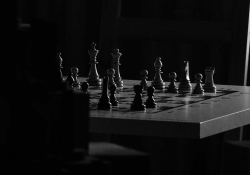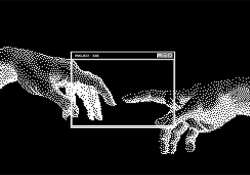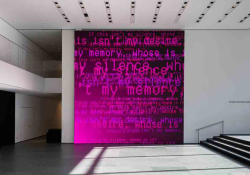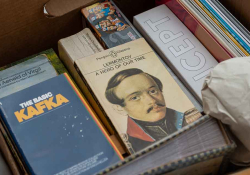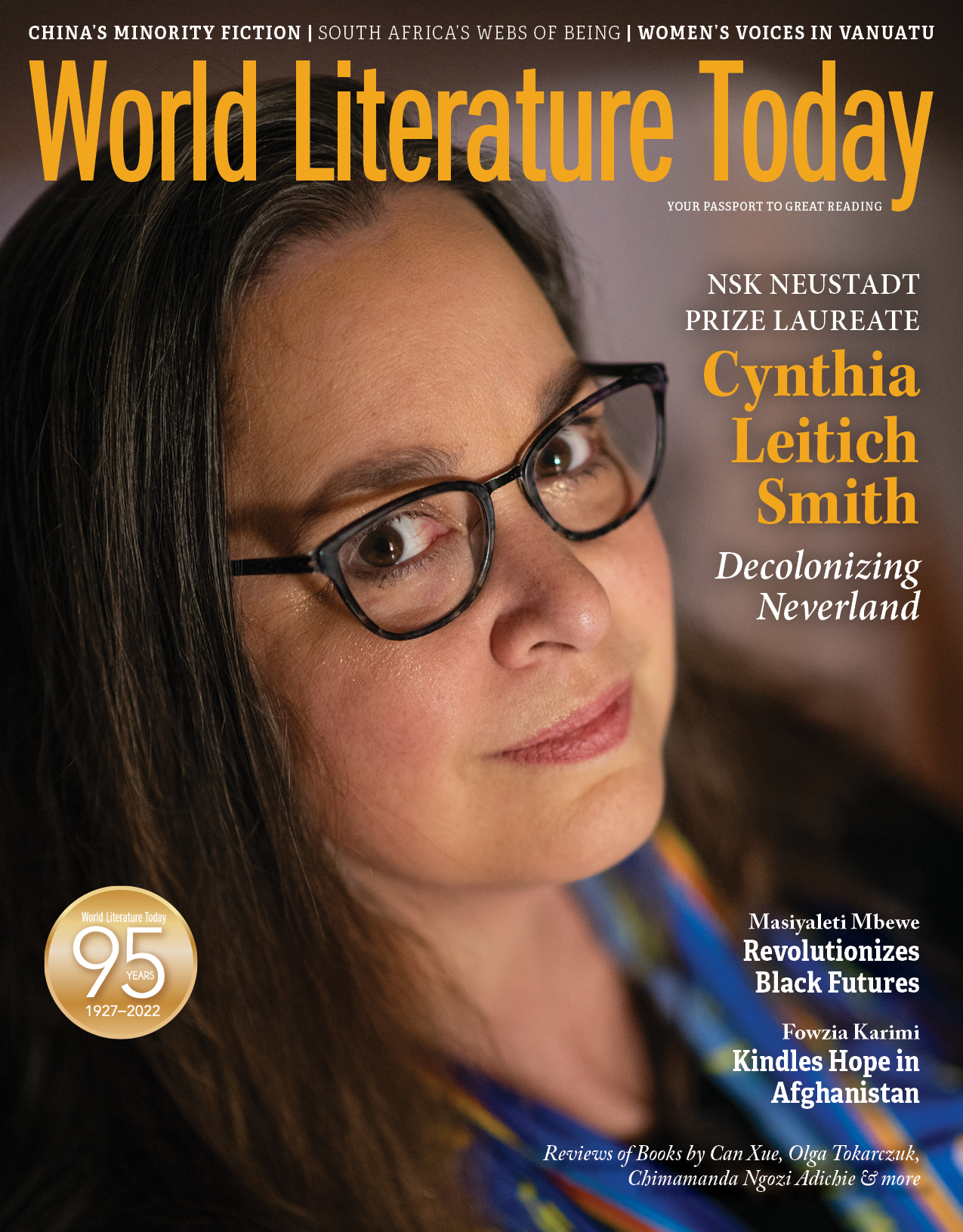Decolonizing Neverland: How Native Voices Are Reimagining Books for Young Readers: The 2021 NSK Prize Lecture
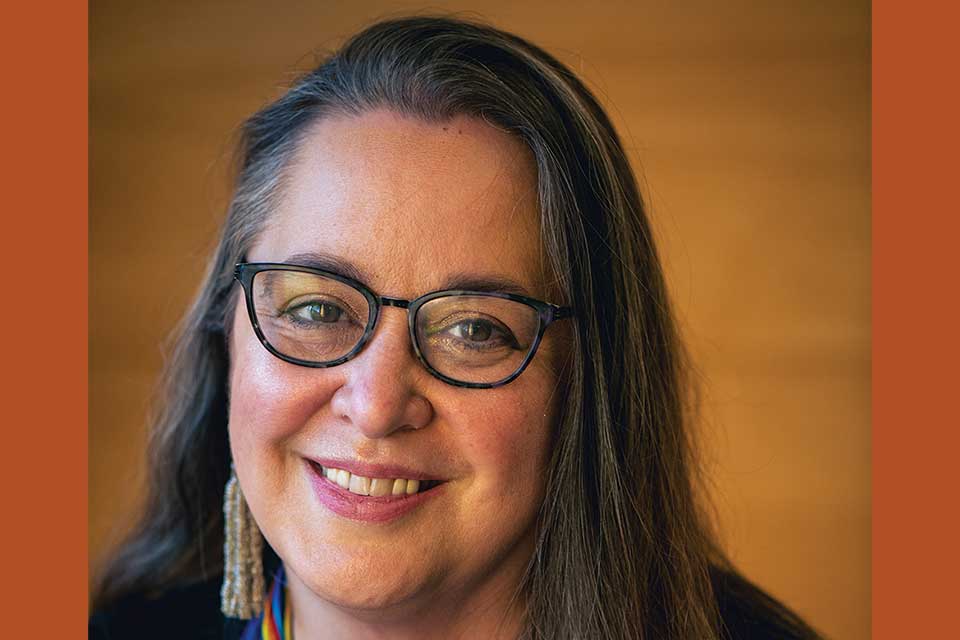
Let’s all take a moment to breathe in some glittering fairy dust and share a wonderful, lovely thought. Let’s contemplate the magic and power of stories and the life-changing impact of books on young readers.
When I was a little girl, my parents would take me sometimes to double features at our local drive-in theater. We’d watch a children’s movie together—often an animated film—and then I’d fall asleep in the back seat of the Oldsmobile while they watched a show for grown-ups.
The year was 1976, the US bicentennial. Gerald Ford was president, and I was seven years old. The double feature was one of the many adaptations of James Matthew Barrie’s Peter and Wendy, also known as Peter Pan, coupled with A Star Is Born, featuring Kris Kristofferson and Barbra Streisand. I enjoyed the beginning of the children’s film. The Darling children were likeable. The character Tinker Bell won my young heart, and I never let go of that affection. I was surprised and interested to later encounter Tiger Lily, a Native girl character, in the story. As I curled up under a fuzzy blanket on the back seat and peeked up at the screen, I worried what my friends and classmates and the neighbor kids thought of the supposed Indian characters in the first movie and if they somehow might connect those ideas and images to me.
Meanwhile, I still adored the idea of fairy dust, of flying off to adventure, of families created by birth and of families forged by shared experiences. I related to a young boy’s longing for a mother, especially one with no grandmother either. No Elders at all. I wanted to befriend Tinker Bell and dearly wished that Tiger Lily and her Tribe made any sort of sense. Or, in other words, I longed for a world in which the magic of story embraced all children. Much of my life’s work has been about contributing to efforts to turn that vision into a reality on bookshelves.
I longed for a world in which the magic of story embraced all children.
Over the years, many of us have labored to nurture a more positive reading landscape, so that every young reader has a multitude of opportunities for positive connections with books. Our conversation will be largely centered on the challenges to achieving that goal, highlighting our progress, and celebrating the company we’ve kept along the way. With that in mind, through the lens of my creative journey, we’ll consider together why and how this is a time of hope and joy when contemplating the rise of Indigenous books for young readers. As a writer who first began her creative journey in the mid-1990s, I’ve had a front-row seat to the expansion, contraction, elevation, and magnification of Indigenous voices and visions in books. I’ll touch on the broader landscape of youth literature, informed by my teaching in a low-residency MFA writing program at Vermont College of Fine Arts and my role as the author-curator of an imprint at a major publisher.
Native peoples have found it helpful to remind everyone else that we have a past, a present, and a future. We’re modern peoples determined to raise up and empower today’s children and teens while planning for generations to come. I’m honored to say that I write for kids and young adults, that I respect and value them as an audience. My relationship to traditional mainstream education—to books and reading—was complicated. My mother’s side of the family relocated from Oklahoma to Missouri when my grandfather, a career serviceman, was transferred to Richards-Gebaur Air Force Base outside of Kansas City, so that’s where I spent most of my childhood, though I frequently traveled to visit relatives in Oklahoma and Tennessee, and many of my formative life lessons were gleaned from kitchen-table conversations. Kitchen-table stories.
One of my earliest memories is of my mother reminding me that I was Indian and to be proud of it, but never to talk about it at school because then the teachers and the other kids wouldn’t like me. She was speaking out of love. School wasn’t considered a safe place, and she was afraid for me. It was a confusing message for such a young child, especially one from an adoring extended family who were drawn to learning. Fortunately, today’s best educators are changing those dynamics. Fortunately, even then, there were caring teachers, and I found close friends who liked me for who I was.
Years later, returning to the children’s/YA sections of bookstores and libraries as an adult was a revelation. We’d come several steps forward in terms of quality and inclusion—albeit in an uneven and limited sort of way. I didn’t yet realize that the progress pendulum was poised to swing back.
While it was still arguably what Nancy Larrick in 1965 had referred to as “the all-white world of children’s books,” the literary conversation was experiencing a “multicultural boom.” This translated to a bounty of picture books—many of them featuring retellings of traditional stories from cultures around the world—and middle-grade novels—largely inspired by landmark historical events, movements, and tragedies—like slavery, the internment of Japanese Americans, the Trail of Tears, the Civil Rights movement—topics touched upon in the curriculum. While every era has its excellent titles, too many of the retellings were appropriated and reframed in opposition to the cultural traditions and values supposedly reflected. Likewise, too many of the novels showcased two-dimensional, paper-doll characters moving through the plot to play-act the historical backdrop and comment on it.
Though Dr. Rudine Sims Bishop’s 1990 observation that children’s and young adult books could serve as “mirrors, windows, and sliding glass doors” was already influential, the oft-stated goal of multiculturalism was to use books to educate white kids about “other” people, especially racial and cultural minorities. Too often depictions of the characters didn’t ring true to the young readers who should’ve been able to recognize aspects of themselves on the page. There wasn’t yet a full appreciation of what wide-ranging representation might look like, including, for that matter, ways in which some white readers were underrepresented, too, when it came to disability, religion, socioeconomic status, sexual orientation, military service, body type, region, and other identity elements. After all, each of us is made up of a myriad of influences. For example, I’ve been influenced by my mid- to southwestern background and my middle-class upbringing, and those are both springboards for many of my stories.
It may be especially noteworthy to those of you who, like me, are living in the US central time zone that, in my early years, it wasn’t unusual for editors to cite the fact that a story was set in the middle of the United States as a reason for rejecting it. I recall a friend sharing a decline letter from a Manhattan publisher in response to a nonfiction geology picture book manuscript. The editor enthusiastically praised the poetic writing but explained that modern kids lived in a world of sidewalks, concrete playgrounds, and paved roads and didn’t interact with rocks. Thank goodness in an ever-more connected world we’re increasingly embracing fictional young heroes and real-life young readers who hail from the East Coast to the West Coast to the Gulf Coast, across the plains, beyond international borders, and around the globe.
Yet we could find glimmers of what was to come. Early visionaries like Michael Lacapa and Shonto Begay, and voices like Luci Tapahonso and Virginia Driving Hawk Sneve. While big-press books were rare, Native-owned presses, tribal presses, small publishers, and those based at universities were—and still are—producing fantastic work, though unfortunately, due to financial limits and systemic issues, those books didn’t end up on enough school and library shelves. As an avid young reader, I didn’t come across them, and even today, when I do author visits and review the host institutions’ collections, they’re still rare.
In the late 1990s, at a bookstore, I found a couple of Joseph Bruchac’s contemporary middle-grade novels, which to me, were a signal that the conversation was finally beginning to open to modern depictions that would reflect kids today. One of my favorites from that time was The Good Luck Cat, by Muscogee author-poet Joy Harjo. We’ve all heard about the power of role modeling, but it merits noting that it can be as effective for grown-ups as it is for kids and teens.
In the process of reading hundreds of children’s and young adult books, I noticed a few recurring qualities in Native children’s/YA literature. First, it was almost entirely historical. The few exceptions, however meaningful, didn’t rise in number to become statistically significant. I also noticed that Native characters were almost exclusively male. They avoided using contractions in speech, possessed a myriad of ghostly or mystical qualities, and resembled clichéd bogeymen from Hollywood cowboy movies. Take J. M. Barrie’s Peter Pan, for example. The non-Indian characters were kidnapped white British children, fairies, mermaids, wild beasts, and storybook pirates who apparently sailed to Neverland. Then we were given these stereotypical Old West mythology Indians—Tiger Lily and her people. As a child, they had not only embarrassed me, they had also baffled me. What were they doing there on that island? What tribe were they from? Why did they leave home to reestablish themselves in Neverland? Why were they acting so strangely, and why was there only one girl?
You may be thinking, what difference does it make? We’re talking about a children’s book, a fantasy. Kids know that it’s fiction, that it’s all make-believe. But do they? I have navigated enough cross-cultural conversations in my life to assure you that the average American and Canadian grown-up has picked up a lot of misinformation from popular culture, so education is a factor here.

But there’s something else in play, too, that goes to the heart of Story, the magic of fiction. Storybooks are miraculous, aren’t they? Think about it. Symbols for words rendered in ink or pixels or illustrations can make us eager to turn the page, weep as if we’ve lost someone dearly beloved, reconsider our worldview, and see ourselves and each other differently—for worse and for better. However, that vicarious experience gleaned from reading only works if we first achieve suspension of disbelief. We’ll clap to save a fairy’s life, if we care about her, because we have suspended disbelief. As far as we’re concerned, at least in that moment, fairies are very much real. But if we’re distracted by a disrespectful or baffling depiction on the page, that distraction can become a roadblock, preventing us from suspending disbelief and embracing the story sufficiently to engage our hearts and let our imaginations take flight. Consequently, authenticity—or put more simply—characters and worlds that ring true are key to the success of any work of fiction.
Authenticity—or put more simply—characters and worlds that ring true are key to the success of any work of fiction.
Both Indigenous books—by writers like Linda Hogan, Susan Power, and Louise Erdrich—and mainstream classics by Charles Dickens, Nathaniel Hawthorne, Bram Stoker, and William Shakespeare were among my teachers, and that’s part of the reason why I often embrace juxtaposition of literary styles or hybrid forms. My debut, the picture book Jingle Dancer, illustrated by Cornelius Van Wright and Ying-Hwa Hu, was hybrid in a different way. It was both a storybook and a concept book.
On one level it was a narrative about a young girl bringing together her powwow regalia with the assistance of women of each generation of her family and intertribal community and then dancing to honor them. On another, it was structured around the number four, an important number in the Muscogee culture. Four—in terms of the rows of jingles on Jenna’s dress, the number of directions in which she travels, the number of women she visits, and, finally, in that she joins three other young dancers at the end of the story to become the fourth. Here’s a brief excerpt:
Tink, tink, tink, tink, sang cone-shaped jingles sewn to Grandma Wolfe’s dress. Every Grandma bounce-step brought clattering tinks as light blurred silver against jingles of tin.
Jenna daydreamed at the kitchen table, tasting honey on fry bread, her heart beating to the brum, brum, brum, brum of the powwow drum.
As I mentioned, the author and illustrator bring much of the story, but so does the audience. It’s interesting to compare, for example, feedback trends from Native and non-Indian readers.
With Jingle Dancer, non-Indians in the early 2000s were often puzzled by the fact that the story wasn’t merely a social studies primer, but instead a story about characters with full lives. Native readers appreciated the book for the very same reason. Both remarked on the character of Cousin Elizabeth, partly because she’s Black and Native—an underrepresented intersectional identity—but also because she’s an attorney and, even today, professional women are rarely depicted in pages of books for our youngest readers. Part of me wishes that choice had been more strategic, but the truth is that I was a recent, twentysomething law school graduate trying to brainstorm reasons why Jenna’s cousin couldn’t attend the powwow, and so I gave her one of mine. Cousin Elizabeth can’t go because she must work instead.
Indian Shoes, an early-reader chapter book, is another example of diverging reader feedback. This collection of daily life adventures about a boy and his grandfather has been called both a short-story collection and a young novel. Mainstream critics of books for very young readers favor more connective transitional tissue in individual stories. Native readers are more comfortable with loosely connected scenes. Indian Shoes has become a noteworthy contribution to children’s literature because it features an urban American Indian family and is one of very few books for this age market—after picture books but before middle-grade novels—centered on Native characters. This glimpse into a Cherokee-Seminole family is brought to life by Cherokee artist Sharon Irla’s cover and Cherokee illustrator MaryBeth Timothy’s interior art. Here’s a brief excerpt:
Ray and Grampa Halfmoon traipsed down the cracked sidewalk of a steel and stone city. Ray tracked Grampa’s steps, danced to the rat-a-tat-a-clang of a trash-can band and skipped beneath the ruffling branches.
Instilling an appreciation for believable, engaging Elders on the page facilitates respect and empathy for them in real life, and that’s ever more crucial.
Although most Native people today reside in cities, that reality is vastly underrepresented in books. Indian Shoes is also one of my many titles that give space and respect for a main character who is an Elder. It’s interesting. Writers for grown-ups often struggle to create three-dimensional kid and teen characters. Writers who’re not yet Elders tend to underestimate the complexity of those who’re further along life’s journey. Yet our largest generation is currently coming in at between fifty-seven and seventy-five years old. Instilling an appreciation for believable, engaging Elders on the page facilitates respect and empathy for them in real life, and that’s ever more crucial.
Readers often ask what’s real and what’s made up, and yes, I know what it’s like to live in the Windy City. But what’s most true about this book is the bond between Ray and Grampa Halfmoon. If Jingle Dancer was my I-love-my-grandma book, then Indian Shoes was my I-love-my-grandpa book.
To me, children’s literature for elementary readers is most resonant when grounded in hope, heart, and wonder. I write both fantasy and realism, and there’s a tendency to associate fantasy with its wonder—its flying kids and fairy dust—while underestimating the importance of wonder in more feet-on-the-ground narratives. Consider another brief excerpt from Indian Shoes:
When the wind whistled into Murphy Family Antiques, Ray and Grampa whistled in with it. . . . the shop brimmed with treasures . . . an autographed baseball . . . ostrich feathers . . . a basket of antique buttons on a pedestal . . . a tabletop held up by a real elephant leg . . . a moose head mounted high on a wall.
Where were the coats that matched the old buttons? Ray wondered. What happened to the rest of the elephant? Who took the body of the moose glaring down?
To me, children’s literature for elementary readers is most resonant when grounded in hope, heart, and wonder.
To be a young child is to live in a perpetual state of wonder, and that’s much of the magic of children’s literature, no matter whether it’s realistic or fantastical, and it’s part of the reason about half of my reader mail comes from grown-ups.

Last year was the twentieth anniversary of my first book, Jingle Dancer, and this year is the twentieth anniversary of my first novel, Rain Is Not My Indian Name. Under any circumstances, an author would pause to reflect on her creative journey at those points, but my anniversary experience was more of a reckoning with the passage of time. I was blessed with the opportunity to revisit my first three books two decades after their original publication dates so that I could update them for rerelease.
It was Métis artist Natasha Donovan who reinterpreted Rain Berghoff for Rain Is Not My Indian Name. The story is about a Muscogee girl, who is also a Cherokee and Ojibwe descendant, on a grief and healing journey after the unexpected death of her best friend. When funding for her aunt Georgia’s Native summer youth program is challenged, Rain takes on a job as a part-time photographer for her small-town newspaper, covering the story. Then she slowly begins to emerge from her sorrow and reconnect to others through the lens of her camera.
Speaking of her cover illustration, Natasha said, “Fireworks are a reference to some important moments in the story, but they’re also a way of representing the explosiveness of loss (both in its wild grief and its unexpected, breathless joy). This decision informed the palette as well; I knew I’d need colours that would transport readers into a slowly cooling summer night filled with the smell of smoke and the sounds of far-off revelry.”
While updating the texts of Jingle Dancer and Indian Shoes was a matter of minor tweaks and new back matter, Rain Is Not My Indian Name was a more major undertaking. When I first embarked on the manuscript in the late 1990s, it had been important that the story feel very modern in large part because contemporary depictions of Native teens, especially Native teen girls, were so rare.
Consequently, the book felt more quickly dated. The story reflected technology of the time of publication, the early 2000s—it was one of the first books to integrate a website—and it also included then-current dynamics around marginalized identity elements. A lot has changed since then. Examples include more younger Indigenous characters skewing to using the term “Native” even though their Elders default to “Indian,” capitalizing “Black” in reference to Black people, and tweaking the sensibility around gender. Society has evolved, and so has what’s now authentic “voice.” The technology also got a major overhaul—“tape recorder” became “voice recorder,” “telephone lines” are now “power lines,” and so on.
Finally, I took a more direct approach to communicating a few cross-cultural interactions. I brushstroked in more clarity and guidance in a scene or two where it might be illuminating.
All that said, I somehow resisted the urge to delete the whole novel and start over. Hopefully, I’ve grown as a writer over the past two decades. Revisiting my early work was a humbling process. But this exercise wasn’t about the book that I could write now. It was about making the book I wrote then still resonant to kids of today. So, never mind that if she’d kept aging in real life, Cassidy Rain Berghoff would be in her thirties by now. When she reemerged in 2018 as a secondary character in an upper-YA novel, she’d only aged two years on the page during the past seventeen years anyway.
From a chapter titled “Rising Rain”:
we ran across the busy highway to this antiques store with a Lucky Strike pinball machine and a jukebox playing rock-and-roll records for a cigar-store Indian. When I crawled back into the shotgun seat of Mom’s car, the vinyl seats toasted my rear end through my jeans shorts and seared the backs of my bare thighs. It was a pretty near perfect day.
Between my third book, Indian Shoes, and my next book centered on Native characters, Hearts Unbroken, twelve years went by. During that time, I wrote a successful series of YA gothic fantasy novels and a spin-off fantasy-adventure trilogy. My mainstream work, though it was more commercial, received better reviews, more awards and acclaim, and hit the Publishers Weekly and New York Times best-seller lists. Clearly, I could connect books with the marketplace, critics, and readers, so you may be wondering what happened with my Native representation on the page. Simply put, there was a retraction in the industry. The multicultural boom had gone bust, and daily life stories of Native kids weren’t considered as necessary as those that filled the slim shelf space in the social-studies curriculum.
Few of us were talking seriously about inclusivity as a source of literary achievement or celebration, and a single voice—usually male—in each underrepresented category was largely considered sufficient.
I had two choices. Surrender or pivot. I pivoted. I’d already tried writing what I knew. So, I decided to try writing what I loved to read, what fascinated me.
I had two choices. Surrender or pivot. I pivoted.
I have always been intrigued by how storytellers rework classics over time, and the power of otherworldly elements to illuminate our own lives and make us care. I wrote contemporary fantasy YA novels with make-believe creatures in conversation with Bram Stoker’s Dracula, Richard Connell’s “The Most Dangerous Game,” and Charles Dickens’s A Tale of Two Cities, among others. The mid- to southwestern, girl empowerment, intergenerational, and cross-cultural themes of my early realistic fiction thrived behind the veil of metaphor.
One of my most memorable author events took place at a juvenile detention center in Kalamazoo, Michigan. The incarcerated teens spoke of recognizing aspects of themselves and their families in the cast of fantastical heroes. They talked about what it felt like to be viewed as the other. They discussed their fears and reflected deeply on whether they, like Miranda in Eternal, could be redeemed. They even speculated on God’s love and the meaning of faith and whether angels were among them. Representation matters, whether it’s realistic or glittering with magic.
Publishing-wise, my work wasn’t quite on trend, but it was a near miss. Though I wasn’t writing genre paranormal romance, the books did have monsters and romantic subplots and drew an overlapping audience. My Native characters fell to secondary status and mostly appeared in my short fiction published in anthologies. I always intended to come back to Native literature in a bigger way. In fact, I was hopeful that maybe raising my profile and proving that I could successfully write a wide range of titles would help secure that opportunity.
Hearts Unbroken was a giant step in that direction. Along with Rain Is Not My Indian Name, it’s among my more quasi-autobiographical works. Neither protagonist Louise Wolfe nor protagonist Rain Berghoff is me in disguise, but I have more in common with them than any of the other characters I’ve written. They’re both bicultural Muscogee teenage girls from middle-class and intertribal mid- to southwestern families. The seed of each story—grief and healing in Rain and the perils of dating while Indian in Hearts Unbroken—sprang from personal experience.
My original concept for Hearts Unbroken was to showcase the world of high school journalism and write a novel-length apology to my high school boyfriend that also integrated an examination of the various kinds of speech—interpersonal speech, political speech, religious, artistic, and journalistic speech—the types of speech that shape our society. The book asks tough questions about the artist versus the art, the speaker versus the speech. It examines the day-to-day challenges of being a Native teen in the middle-class suburbs and touches on ripple effects of history. It’s a stereotype buster, reminding readers that Native teens are modern teens. Some live in predominantly tribal communities, and some don’t. The majority—like most of my characters—move back and forth in between.
Louise Wolfe is a member of a tight-knit Native family, but she also goes to a predominantly white high school. A white girl named Shelby is her best friend in the world, and her boyfriend is a Lebanese American budding photojournalist.
I mentioned Dr. Rudine Sims Bishop’s observation that books can be windows, mirrors, or sliding glass doors. Author Uma Krishnaswami adds to this metaphor the idea of prisms, the multicolorful, ever-changing glow that’s created over time by intersections in the light. A romantic relationship between an Indigenous girl and a Lebanese American boy, a platonic best friendship between an Indigenous girl and a white girl—those are prisms. So is a Muscogee girl character who is also a US midwesterner as well as middle class and Protestant.
Like Rain Is Not My Indian Name, Indian Shoes, and my YA fantasy novels, Hearts Unbroken features a lot of humor. Not everyone will get every joke, and that’s okay. That’s a high bar—for anyone to get every joke. It takes time, exposure, and commitment to build a meeting of the minds sufficient to generate laughter. Likewise, Hearts Unbroken acknowledges a cultural tradition through a brushstroke that most readers will miss, but it will be especially meaningful to those who do recognize it.
Nambé Pueblo author, scholar, and activist Dr. Debbie Reese hosts a critical review and resources site with Dr. Jean Mendoza called American Indians in Children’s Literature. It was Dr. Reese who added the idea of curtains to Dr. Bishop’s representation metaphor. Essentially, the idea of curtains is that not every aspect of identity or heritage is public or for the taking. I agree with that philosophy and strategically integrate the occasional sly wink to certain readers where it’s appropriate.
Writing three-dimensional characters means writing characters with flaws, and Louise has her share of them. Like a lot of teens, like a lot of humans, she gets so caught up in her own problems that sometimes she forgets that the important people in her life need attention and support, too.
Fortunately, Lou’s friend Shelby eventually loses patience and calls her out on it. Here’s an excerpt:
“Do you have any idea how spoiled you are?” Shelby asked. “. . . you’ve never had to earn a dime, and don’t pretend that doing household chores for your parents or babysitting your perfect little brother or playing office with your doting older cousin counts. Because it doesn’t. That’s fun money. Spending money. You do whatever you want with it. Meanwhile, when I finally get a few minutes to spare, you’re completely blowing me off except for when you want to talk, talk, talk, talk about yourself.”
Life is not without its struggles or its heroes who rise to meet them. Speaking of heroes, while I was writing Hearts Unbroken, something remarkable happened. An up-and-coming group of incredibly talented children’s/YA authors and illustrators turned a hashtag into a movement and finally into a nonprofit organization called We Need Diverse Books. They expanded the focus beyond the goals of the multicultural movement that had preceded them to become a transformative force. One morning, Ellen Oh, an acclaimed author and co-founder of We Need Diverse Books, invited me to breakfast during an educator conference. I figured we’d catch up over eggs and pancakes before our first session, and we did. She mentioned in passing how wonderful it might be if there was a children’s/YA book imprint devoted to Native voices. I agreed. Then Ellen suggested that I’d be the perfect author to curate it, and I said no. That job should clearly go to someone more established. A bigger name, I said. Cheerfully undeterred, Ellen pointed out that I’d been in the business for a couple of decades and had published a wide range of books across age markets, genres, and formats. She also reminded me that I had been teaching writing for several years, which was solid preparation for nurturing new and up-and-coming voices. I promised to think about it, and that was that. Except occasionally, whenever I’d hear from Ellen, she’d nudge.
Months later, National Book Award finalist Debby Dahl Edwardson invited me to teach LoonSong: Turtle Island, a weekend workshop specifically for Native children’s/YA writers. It was a deeply inspiring experience at a rustic lakeside lodge in Cook, Minnesota, on Ojibwe ancestral land.
There were two moments that weekend that changed everything. The first was a question asked by Debby’s daughter, Aaluk Edwardson, an Iñupiat writer, challenging me to do more to improve the publishing industry, to do better, to step up and change a relatively unwelcoming landscape for underrepresented voices, for Indigenous voices in particular. You know, it’s easy to say “fight the power” until you realize that, to a certain extent, you are the power. No, I was by no means a publishing bigwig, but I had more of a voice in the industry than a newer, up-and-coming voice.
A few days later, I was sitting out on the lodge’s screened-in porch. It was a gorgeous afternoon. The lake sparkled. The manuscripts of the participating Native writers were spread out in front of me, and they were spectacular. I remembered Ellen’s encouragement to launch a Native-focused imprint, looked at those stories, and thought, we could do this. After returning to Austin, I reached out to Ellen and asked if she was still interested in the imprint, in the idea of We Need Diverse Books partnering with a major publisher to create a line of books by Native creatives for all young readers. Ellen said yes. I reached out to legendary children’s/YA book editor Rosemary Brosnan at HarperCollins because of her formidable skill set and because I trusted her. She said yes, too.
Heartdrum is now a Native-focused imprint of HarperCollins Children’s Books. Our debut list of five books has earned a combined nineteen starred reviews—multiple stars for each title—from major trade publications and numerous honors. Today, Native representation is so much better than when I was a kid—more authentic, nuanced, respectful, resonant, thoughtfully rendered, funny, and even fun.
For too long, there was the idea that one Native voice for kids and teens was enough. One star to somehow represent more than a thousand Indigenous Nations across what’s currently called North America. One star to reflect unique cultures, languages, histories, the experience of Black Native people and disabled Native people and those for whom Spanish is their first language and . . . I could go on.
Suffice it to say, we’re now and forever more a constantly expanding constellation. We will never settle for one star again.

We’re now and forever more a constantly expanding constellation. We will never settle for one star again.
Ancestor Approved: Intertribal Stories for Kids is a baby step toward providing a diverse and varied glimpse into the contemporary intertribal community within the United States and Canada. The stories and poems by sixteen writers, embodied in the cover illustrated by Navajo artist Nicole Niedhardt, take place before, during, and after the Dance for Mother Earth Powwow in Ann Arbor, Michigan. What I appreciate most about the book is that the various pieces are linked together. Characters reappear. The world-building was a joint project. This undertaking was also about community off the page—introducing new voices like Cherokee Andrea Rogers to accomplished Elders like Choctaw Tim Tingle. The contributors collaborated via online message board, emails, text messages, phone calls—every twenty-first-century means of communication at our disposal.
With that in mind, I’d like to read an excerpt from a poem from the collection by Wichita writer Kim Rogers, who hails from Oklahoma. She currently has three picture books under contract with Heartdum. Kim wrote,
A powwow is
prizes and recognition.
But community
is the best prize of all.
We began this conversation by breathing in fairy dust and since then have traveled well past the second star, and so now it seems only fitting that we conclude with a brief peek into my latest novel, Sisters of the Neversea, with cover art by Black Muscogee artist Floyd Cooper. It’s fair to say that my subconscious has been rewriting J. M. Barrie’s Peter Pan since I was that little girl in the back seat of my parents’ Oldsmobile, pretending to be asleep. The heart of my story is the love between the co-protagonists, Lily Roberts and Wendy Darling, who’re stepsisters living in suburban Tulsa.
Probably the best response I’ve received so far was from a Native teacher who told me how happy she was to finally have a Peter Pan story that she felt good about sharing with her grandchildren.
In the following excerpt, all you need to know is that Wendy and Michael Darling have flown off to Neverland with Peter and Belle. Stepsister Lily kept her feet on the ground but now feels compelled to follow her beloved siblings and bring them home.
Lily felt the shadow grip her hand. She felt herself drawn forward. On fearful reflex, she gripped the window frame. She took a breath, focused again. She recalled the bright Tulsa morning when Michael was born. She remembered Wendy’s voice, reading Ella Enchanted. Wendy needed her. Michael, too.
Lily flew though the open window, and up, up, up, up.
Lily opened her eyes, took a trembling breath of the night, looked to the right.
“Hello, stars,” she said.
Here’s to a more inclusive, engaging, and respectful reimagining of children’s and teen literature wherein any young character can be a hero that everyone cheers, where we find diverse representation—defined broadly in the bylines and the structures and worldviews that frame the stories themselves. There’s still much work to be done, but it’s fair to say that if we can decolonize Neverland, we can do anything.
Austin, Texas
October 27, 2021
